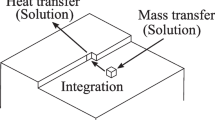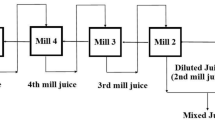Abstract
Pursuit of the identification and reduction of losses, and consequently of increased industrial efficiency, is a constant challenge in sugarcane industries. However, little attention is given to the undetermined losses, despite the high impact they can have on industrial efficiency. Therefore, this work aimed to quantify the contribution of the sugar-manufacturing sector to the total undetermined losses of a sugar and ethanol plant, presenting a method that could be applied to any equipment or sector of the industry in order to help identify sugar losses. The method was based on data reconciliation for the process flow rates and concentrations and was applied to the juice concentration sector. A mass balance was then applied to the subsequent sectors (crystallization, centrifugation, and drying) with the purpose of calculating the sugar production and comparing it with the real production. Considering the entire period studied, the calculated sugar production was 1.0% higher than the real production, and 37.3% of undetermined losses were found to occur between juice concentration and sugar bagging.





Similar content being viewed by others
Abbreviations
- F :
-
Mass flow rate (kg/h)
- Q :
-
Volumetric flow rate (m3/h)
- s :
-
Sucrose mass concentration (%)
- ρ :
-
Density (kg/m3)
- 1:
-
Clarified juice
- 2:
-
Clarified syrup
- 3:
-
Final molasses
- 4:
-
Sugar
References
Beckman, James R. 1982. Data adjustment for non-reactive batch or steady-state processes. Chemical Engineering Communications 15: 357–365. https://doi.org/10.1080/00986448208911081.
Chen, James C.P., and Chung C. Chou. 1993. Cane sugar handbook: A manual for cane sugar manufacturers and their chemists, 12th ed. New York: Wiley.
Chou, Chung C. 2000. Handbook of sugar refining: A manual for design and operation of sugar refining facilities. New York: Wiley.
Copersucar. 1978. Controle Químico da Fabricação do Açúcar. São Paulo: Copersucar.
Crowe, Cameron M. 1996. Data reconciliation—progress and challenges. Journal of Process Control 6: 89–98. https://doi.org/10.1016/0959-1524(96)00012-1.
Davis, S.B. 2001. The chemistry of colour removal: A processing perspective. Proceedings of the South African Sugar Technologists’ Association 75: 328–336.
Fernandes, Antonio C. 2011. Cálculos na Agroindústria da Cana-de-açúcar, 3rd ed. Piracicaba, SP: STAB.
Hubbard, G., and D. Love. 1998. Reconciliation of process flow rates for a steady state mass balance on a centrifugal. Proceedings of the South African Sugar Technologists’ Association 72: 290–299.
Hugot, Émile. 1986. Handbook of cane sugar engineering, 3rd ed. Amsterdam: Elsevier.
Jiang, Xiaolong, Pei Liu, and Zheng Li. 2014. Data reconciliation and gross error detection for operational data in power plants. Energy 75: 14–23. https://doi.org/10.1016/j.energy.2014.03.024.
Kneile, Robert. 1995. Wring more information out of plant data. Chemical Engineering (New York) 102: 110–116.
Lopes, Claudio H., and Maria T.M.R. Borges. 2004. Manual de análise de açúcar: Açúcar VHP, VVHP, demerara, cristal, refinado e açúcar líquido. Araras, SP: Sucral.
Martins, Márcio A.F., Carolina A. Amaro, Leonardo S. Souza, Ricardo A. Kalid, and Asher Kiperstok. 2010. New objective function for data reconciliation in water balance from industrial processes. Journal of Cleaner Production 18: 1184–1189. https://doi.org/10.1016/j.jclepro.2010.03.014.
Martins, Sara I.F.S., Wim M.F. Jongen, and Martinus A.J.S. van Boekel. 2001. A review of Maillard reaction in food and implications to kinetic modelling. Trends in Food Science & Technology 11: 364–373. https://doi.org/10.1016/S0924-2244(01)00022-X.
Mullin, John W. 2001. Crystallization, 4th ed. Woburn, MA: Butterworth Heinemann.
Narasimhan, Shankar, and Cornelius Jordache. 2000. Data reconciliation & gross error detection: An intelligent use of process data. Houston: Gulf Publishing Company.
Romagnoli, José A., and Mabel Cristina Sánchez. 2000. Data processing and reconciliation for chemical process operations. London: Academic Press.
Schlumbach, Karl, A. Pautov, and Eckhard Flöter. 2017. Crystallization and analysis of beet and cane sugar blends. Journal of Food Engineering 196: 159–169. https://doi.org/10.1016/j.jfoodeng.2016.10.026.
Smaïli, F., D.K. Angadi, C.M. Hatch, O. Herbert, V.S. Vassiliadis, and D.I. Wilson. 1999. Optimization of scheduling of cleaning in heat exchanger networks subject to fouling. Food and Bioproducts Processing 77: 159–164. https://doi.org/10.1205/096030899532312.
Syed, Mohammed S., Kerry M. Dooley, Frantisek Madron, and F. Carl Knopf. 2016. Enhanced turbine monitoring using emissions measurements and data reconciliation. Applied Energy 173: 355–365. https://doi.org/10.1016/j.apenergy.2016.04.059.
Acknowledgements
The authors obtained financial support from CNPq (Conselho Nacional de Desenvolvimento Científico e Tecnológico).
Author information
Authors and Affiliations
Contributions
BJCC and AB conceived the work. BJCC developed the research and wrote the manuscript, with support from Bernardo. Both BJCC and AB contributed to the interpretation of the results and to the final version of the manuscript. AB supervised the project.
Corresponding author
Ethics declarations
Conflict of interest
Castro reports grants from Conselho Nacional de Desenvolvimento Científico e Tecnológico, during the conduct of the study. Dr. Bernardo reports grants from Conselho Nacional de Desenvolvimento Científico e Tecnológico, during the conduct of the study.
Electronic Supplementary Material
Below is the link to the electronic supplementary material.
Rights and permissions
About this article
Cite this article
de Castro, B.J.C., Bernardo, A. Data Reconciliation Applied to Loss Identification in the Sugar Industry. Sugar Tech 21, 486–495 (2019). https://doi.org/10.1007/s12355-018-0649-4
Received:
Accepted:
Published:
Issue Date:
DOI: https://doi.org/10.1007/s12355-018-0649-4




